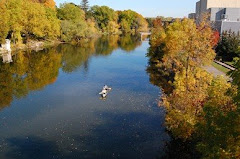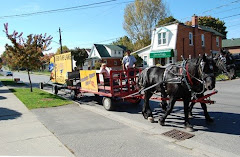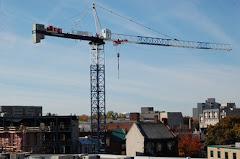All week, as environmentally concerned Canadians have been stewing about the greenlight given to Enbridge for the Northern Gateway pipeline. Still, as noted in many media sources, the governmental go-ahead came with conditions, a set of 209 caveats that Enbridge needs to meet in the interest of safety and environmental stewardship. But what are these 209 conditions. All the media reports have noted the conditions and that there are 209 of them, but for the full list, you have to go the Report of the Joint Review Panel for the Enbridge Northern Gateway Project itself to get them. It's an appendix that you have to scan to the bottom of the over 400 page document to get, so in the interest of time and information, I thought I would post them here.
Here's the list of 209 conditions courtesy of the Report:
PHASE #1 - OVERARCHING
1) First and foremost, the pipeline must comply with all of the certificate conditions.
2) The sunset clause, unless the National Energy Board (NEB) says otherwise, construction of the pipeline and the Kitimat terminal has to start by December 21,2016.
3) Northern Gateway must file with the NEB, within 30 days after commencing operations.
4) A requirement for filing on an annual basis the audited financial statements for the pipeline, and a quarterly filing for pipeline throughput.
5) Project facilities have to be designed according to minimum specifications, standards, policies, mitigation measures, and procedures.
6) Northern Gateway must observe the minimum standard of all policies, practices, programs, mitigation measures, recommendations, and procedures for the protection of the environment.
7) A timeline for filing updates during construction.
8) Northern Gateway has to file 7 months before construction begins, a complete list of construction spreads, regions, or work areas that, for the duration of Project construction. Construction can't begin till all pre-conditions are met.
9) The project has to file a list of all infrastructure sites 90 days before the start of construction.
10-13) The project must file a diagram of its organization structure (i.e., project management, design, and field staff) "that clearly identifies roles, accountabilities, responsibilities, and reporting relationships for the applicable Project component."
14-15) "Northern Gateway must use a three-layer composite coating or High Performance Composite Coating (a proprietary Bredero-Shaw product) for the pipeline between kilometre post 600 and the Kitimat Terminal."
16-17) "Northern Gateway must install pipe that, at a minimum, meets the requirements of Canadian Standards Association (CSA) Z245.1 Category III pipe."
18) Marine Voluntary Commitments - a list of 14 different provisions that Northern Gateway has to cover in order to protect the waterways around Kitimat that has to be filed 90 days before the first tanker is loaded.
19) Oil can't start streaming out of Kitimat until TERMPol Review Committee recommendations have been met and notice is given 90 days in advanced.
20) The filing of Transportation Service Agreements (TSAs) with shippers "to demonstrate that it has secured sufficient commercial support for the Project." In this case, the oil pipeline.
21) Same condition for the condensate pipeline.
22) Approval of tolls of shippers and information needed for the contracts.
23) A list of further reports to be filed with the NEB.
24) The project must maintain records of its landowner consultations.
25) Northern Gateway must keep a record of all complaints against the project from pre-construction to the end of operations.
26) Northern Gateway has to tell the NEB within 14 days of applying if they intend to use Temporary Foreign Labour.
PHASE #2 - PRIOR TO CONSTRUCTION
27-29) The project has to come up with a plan for monitoring the environmental effects of the pipeline within 1 year of being issued its certificate.
30-32) The creation of a survey framework to take into a account all species and habitats along the pipeline route.
33-35) Northern Gateway will have to file results of monitoring and surveying within 45 days of each segment's completion.
36) "Northern Gateway must file with the NEB for approval, within 1 year after the certificate date, a Marine Environmental Effects Monitoring Program for the Project’s operational life."
37) Same timetable for developing a survey framework for monitoring marine life.
38) Reporting dates for the monitoring and survey framework for marine environment.
39-41) A quality management plan is to be filed at least 6 months before any pipe or major component is to be built.
42-43) Three months prior to pipe manufacturing, a report has to be filed testifying that it was the proper strength and resistance.
44-45) Completion of testing on the fracture toughness of the piping.
46-48) A joining program must be filed 30 days before any welding can be initiated.
49) A list of Fisheries Liaison Committee (FLC) meeting summaries must be filed a year before in-water construction begins at the Kitimat terminal.
50) Marine Mammal Protection Plan development must be completed 9 months before construction of the Kitimat terminal.
51) Creation of Marine Mammal (AKA: whales) Protection Plan to be completed 6 months before in-water construction.
52) Establishment of guidelines for the FLC
53-56) Filing of a Traditional Land Use (TLU) investigation plan for routing and design of the pipeline to be sent to the NEB and copied to affected Aboriginal groups.
57-59) Pre-construction caribou habitat assessment to be completed 6 months prior to construction.
60-62) Caribous Habitat Restoration Plan to be created should their habitat be disturbed.
63-66) Construction Environmental Protection and Management Plan (EPMP), a "comprehensive compilation of all environmental protection procedures, mitigation measures, and monitoring commitments," associated with the project.
67-70) Wetlands Functional Assessment Plan, a list of species at risk, what wetland areas may be affected, and the "avoidance, minimization, and compensation" to ensure no loss of wetlands.
71-73) Linear Feature Management and Removal Plan, meaning how Northern Gateway intends to deal with forests, and other natural features that get in the way of the pipeline.
74-75) Access Management Plan, which ensures access to lands that the pipeline runs through for both humans doing construction and maintenance and the animals who call that land home.
76) Aboriginal, local, and regional skills and business capacity inventory, a list of available skilled labour and businesses that may be able to offer support for construction, as well as a communications plan between the locals and the pipeline construction crew.
77) Training and Education Monitoring Plan
78) Socio-Economic Effects Monitoring Plan
79) Training and education monitoring reports
80-81) Valve Spacing - the final layout of the placement of all the valves along the pipeline to be submitted 6 months before the start of construction.
82) Air Quality Emissions Management and Soil Monitoring Plan
83) Construction schedule
84) Security Programs
85) Emergency Response Plan for construction
86-88) Technology and site-specific mitigation related to emergency preparedness and response
89-92) Pre-construction TLU investigation report (as per conditions 53-56)
93) Aboriginal, local, and Regional Employment Monitoring Plan (AKA: jobs for people in the pipeline's neighbourhood)
94) Aboriginal Contracting and Procurement Monitoring Plan -in order to make the pipeline more appealing to Aboriginal groups they're putting specific emphasis on Aboriginal peoples reaping some of the benefits of pipeline construction.
95-98) Protection and management plan for post-AD 1846 culturally-modified trees (CMTs), any trees pre-AD 1846 are automatically protected.
99-101) Acid rock drainage monitoring and follow-up program - meaning the monitoring of acidic water that outflows from mining operations to avoid contamination with well water/drinking water.
102-105) Surveys and mitigation for rare plants and ecological communities
106-109) Construction safety manuals
110-111) Complementary leak detection systems
112-115) Heritage resources, pipeline construction must be mindful of archaeological and heritage resource permits and clearances in both BC and Alberta.
116) Marine voluntary Commitments and the TERMPol Review Committee recommendations – implementation, monitoring, and compliance
117-119) Emergency preparedness and response planning – document preparation
120-121) Freshwater Fish and Fish Habitat Compensation Plan
122) Marine Habitat Compensation Plan
123) Post-construction environmental monitoring methods (terrestrial and freshwater)
124) Secondary containment at the Kitimat Terminal. - You know, just in case.
125-126)Watercourse crossing designs - a specific and important element to pipeline design as the line intersects with waterways like rivers and lakes. The government has a set of guidelines and manuals specifically for these sensitive portions of the pipeline route.
127-128) Provisional least risk periods - Insurance that the impact on wildlife is minimized and habitats are protected.
129-130) Tunnel infrastructure - protection of ground water and geological stability in the construction of tunnels.
PHASE #3 - PRIOR TO OPERATIONS/DURING CONSTRUCTION
131) Construction progress reports
132-134) Quality assurance and control plans and procedures
135) Aboriginal, local, and regional employment monitoring reports
136) Aboriginal contracting and procurement monitoring reports
137) FLC – annual report
138) Construction Marine Mammal Protection Plan reporting
139-140) Trenchless watercourse crossing completions and contingency plans
141-142) Construction outside of least risk periods
143-144) Pipeline construction within tunnels
145-147) Geohazard Assessment, Mitigation, and Monitoring Report - According to Wikipedia, Geohazards are "geological and environmental conditions and involve long-term or short-term geological processes."
148-150) Updated engineering alignment sheets and drawings
151-153) Specifications for field-applied coatings
154-155) Pipeline overpressure risk reduction - "Northern Gateway must ensure that the maximum operating head profile of the pipeline is greater than or equal to the maximum discharge head of the upstream pump station."
156-158) Field changes manual for geohazard mitigation
159-161) NDE of final tie-in welds - NDE stands for Non-Destructive Evaluation.
162-163) Radiographer and ultrasonic technicians - Canadian General Standards Board-certified technicians have to be hired to operate NDE inspection equipment.
164-166) Pressure testing
167) Enhanced marine spill trajectory and fate modelling - You know, just in case.
168) Consultation with interested parties on emergency preparedness and response
169) Research program on the behavior and cleanup of heavy oils - Again, just in case.
170) Annual research program progress reports
171) Pre-operations emergency response exercises - Covering a variety of scenarios.
172) Emergency Preparedness and Response Exercise and Training Program
173) Filing Marine Oil Spill Preparedness and Response Plans with federal and provincial authorities - Has to be filed one year before operations begin.
174-175) Emergency Preparedness and Response Plan for the pipeline
176) Emergency Preparedness and Response Plan for the Kitimat Terminal
177-178) Tunnel access control plan and safety systems
179) Availability of enhanced marine spill trajectory and fate models for spill responders
180) Third party damage prevention – condensate pipeline
181-182) SCADA and leak detection system design - SCADA stands for Supervisory Control and Data Acquisition
183-184) Overpressure protection
185-186) Column separation - Nothern Gateway has locate places for potential "slack line flow" when the pipeline is at 100 per cent of its maximum operating pressure (MOP), 80 per cent MOP, and 50 per cent MOP.
187) Financial Assurances Plan – operations phase - Nine months before being given the green light to start operations, Northern Gateway has to develop a "Financial Assurances Plan that includes details of the financial resources and secured sources of funds that will be capable of covering the costs of liabilities for, without limitation, cleanup, remediation, and other damages caused by the Project during the operations phase."
188-190) Offset Measures Plan for residual effects on caribou habitat - The project has to be prepared for any impact it had in what it "directly- and indirectly-disturbed caribou habitat."
191) Operations Marine Mammal Protection Plan
PHASE #4 - AFTER COMMENCING OPERATIONS
192) Emergency response exercises during operations
193) Final research program report
194) Caribou Habitat Restoration and Offset Measures Monitoring Program - annually
195) Caribou monitoring reports
196) Post-construction environmental monitoring reports (terrestrial and freshwater) - after the first, third, fifth and tenth growing seasons from project completion
197) Pipeline Environmental Effects Monitoring Program: monitoring results - annually
198) Marine Environmental Effects Monitoring Program: monitoring results - annually
199) Operations Marine Mammal Protection Plan reporting - annually for the first five years, every five years after
200) Ongoing implementation of Marine voluntary Commitments and the TERMPol Review Committee recommendations - twice yearly
201-202) Quality program for the complementary leak detection systems - after the first, third, fifth and tenth full year of operation
203-204) Quality program for the SCADA and leak detection systems - every other year till year five, then every fifth year
205) Financial Assurances Plan – reports and updates
206-207) Pipeline inspections - typically every two years
208-209) Pipeline Geographic Information System (GIS) data



















No comments:
Post a Comment